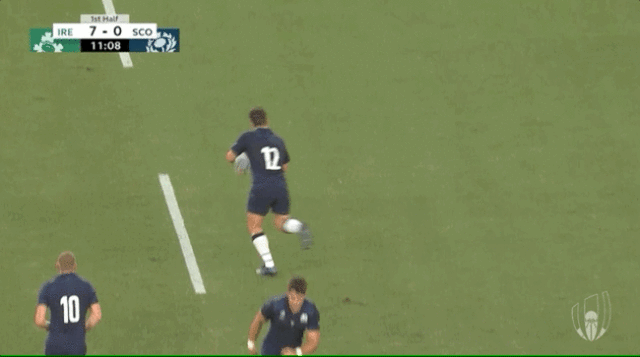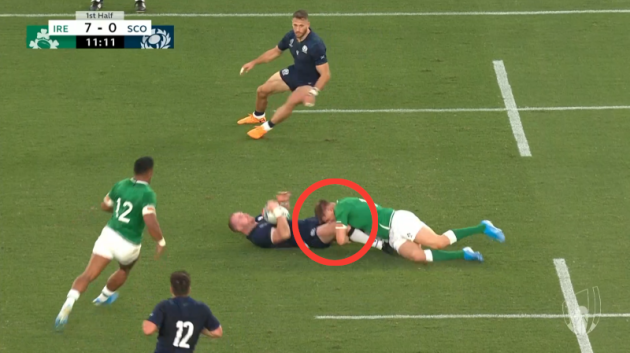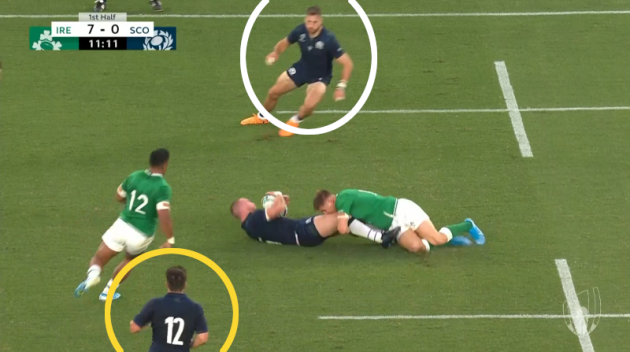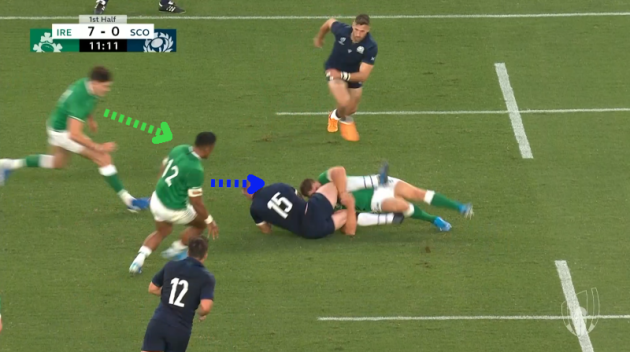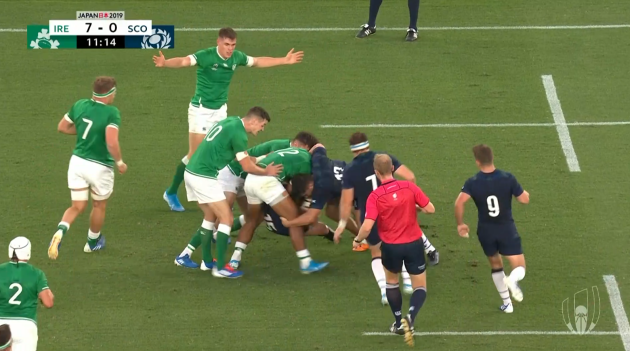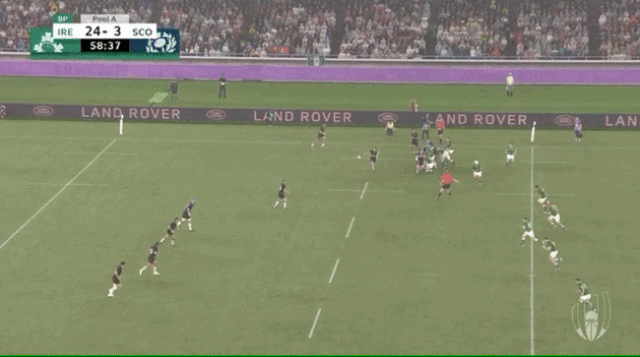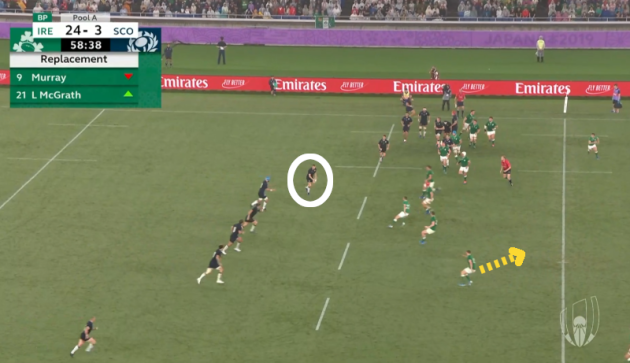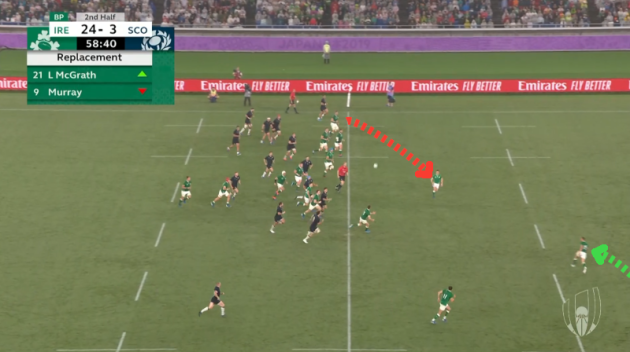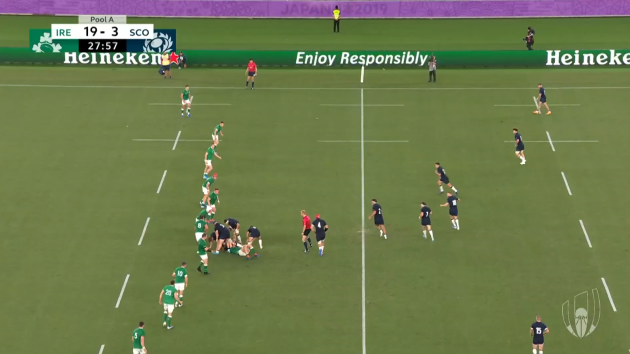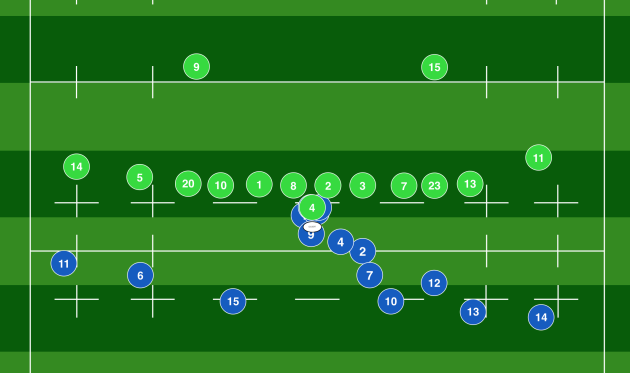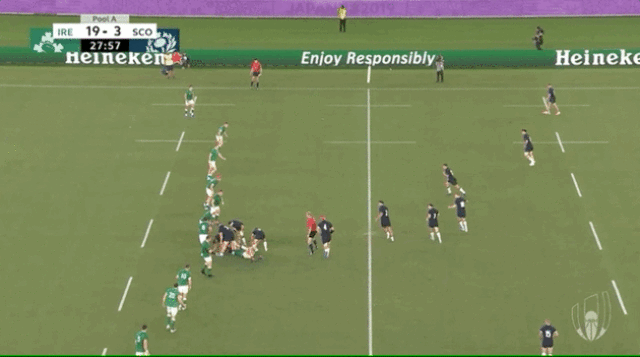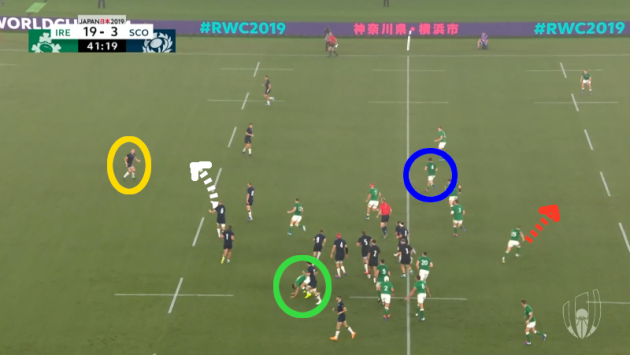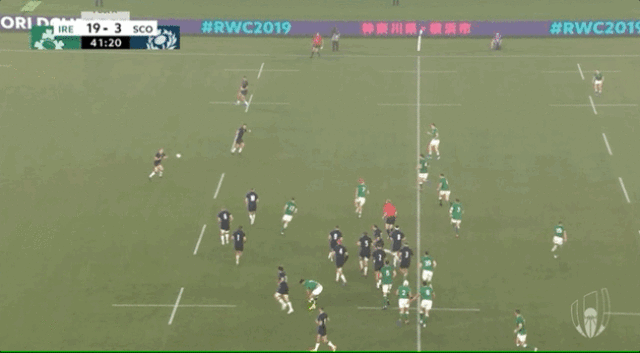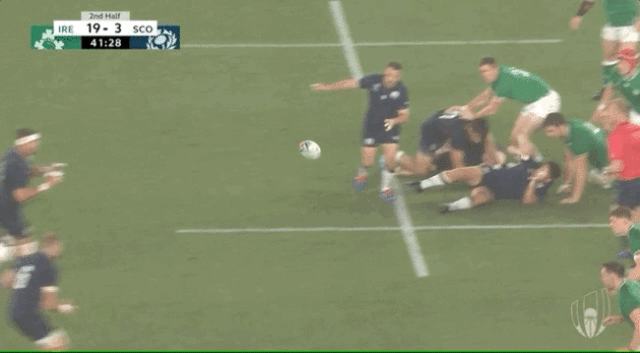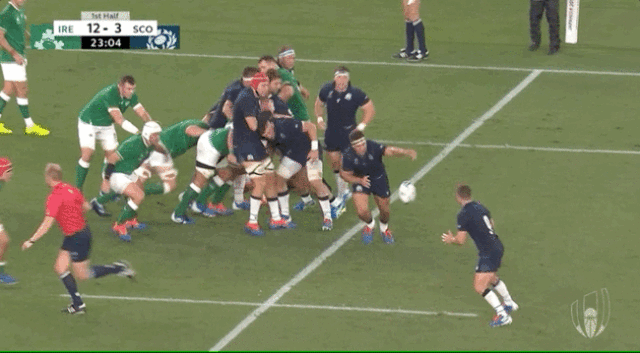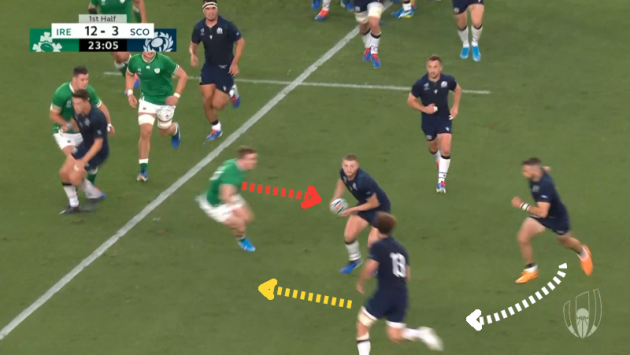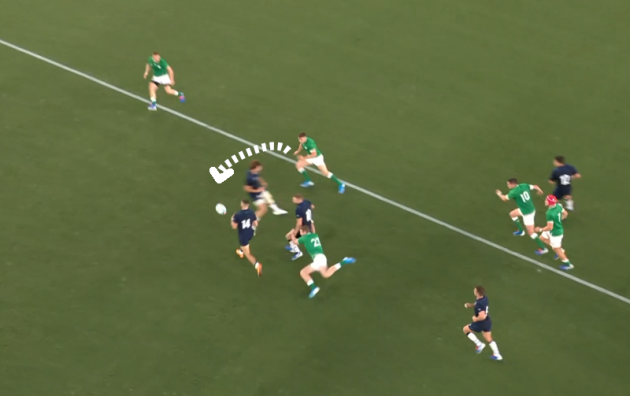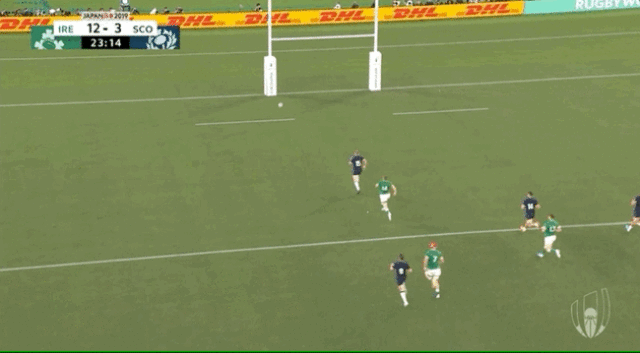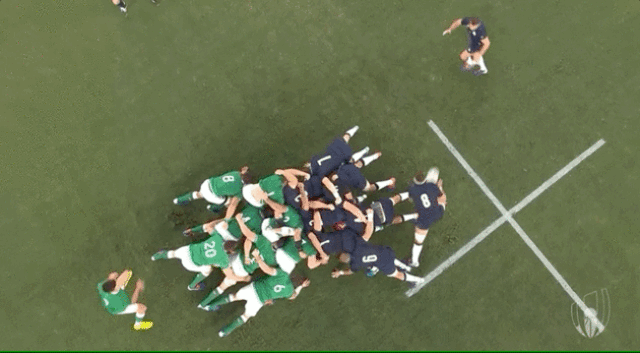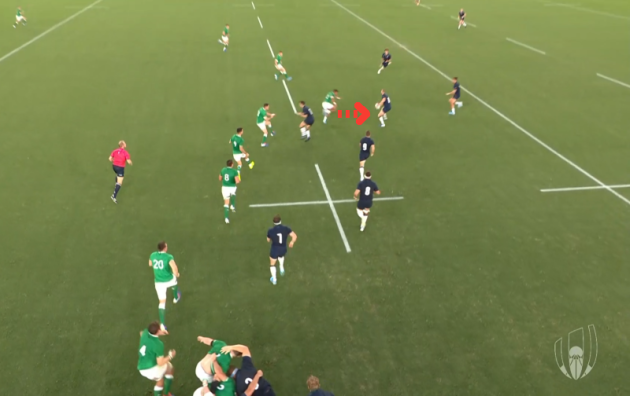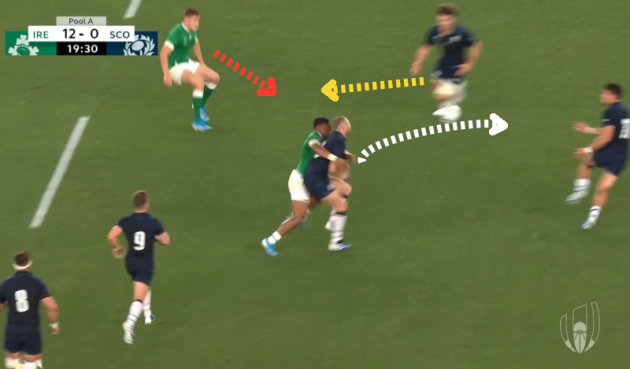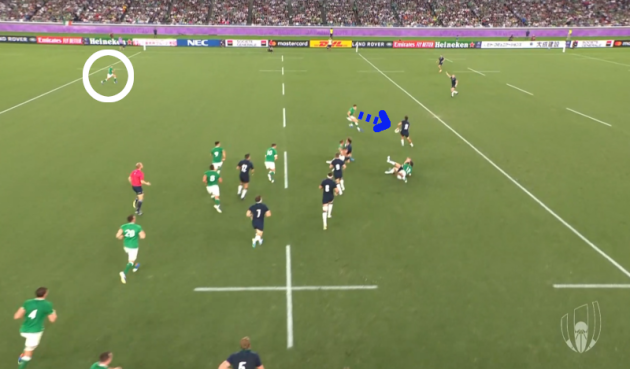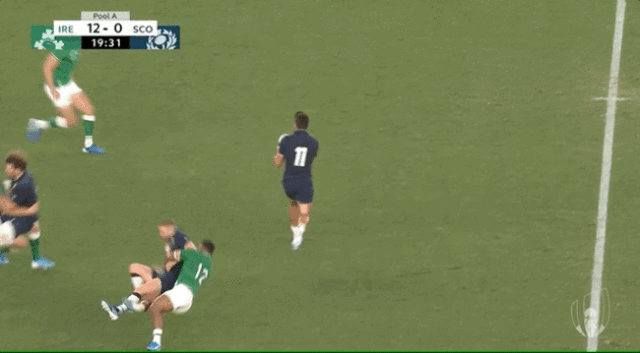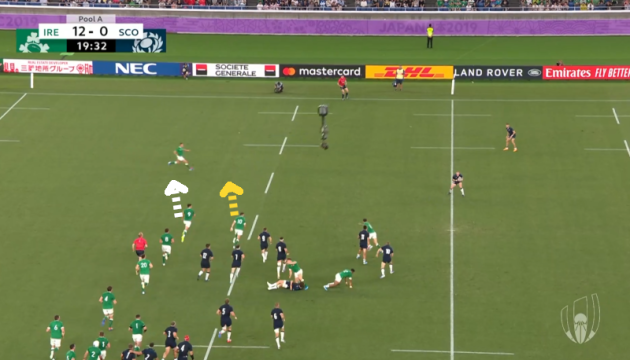ONE OF THE STATISTICS that Joe Schmidt will have enjoyed most from Ireland’s win over Scotland is the 10-3 linebreak count in his side’s favour.
There would have been frustration for the Ireland boss that his players didn’t turn all of those breaks into tries, but it makes for good reading nonetheless – both in terms of Ireland creating opportunities and also how they limited Scotland’s attack.
Andy Farrell, the defence coach, can take some pleasure in Ireland’s 94% tackle success rate too – the best of any team in the World Cup so far – with just eight missed tackles over the course of the game underlining how accurate Ireland were without the ball.
Missed tackle stats can be misleading but this figure underlines the impression anyone who watched Sunday’s game would have had – Ireland’s defence was excellent.
Having been torn apart by England during the World Cup warm-ups, Ireland improved a week later against Wales before delivering a superb defensive performance against the Welsh back in Dublin. Sunday’s showing now makes it two of those in a row and bodes well for the rest of the World Cup.
While Farrell and Schmidt will still pick out deficiencies against Scotland, Ireland’s defensive performance was a key contributor to their dominant 27-3 win.
Shutting down off set-piece
Ireland defended particularly well off lineouts, frustrating the Scots and denying them the ability to build momentum. We get an early example below, as Gregor Townsend’s side move the ball wide into dangerous fullback Stuart Hogg’s hands.
Greig Laidlaw passes [white below] to out-half Finn Russell, who throws a tunnel pass [yellow] between Sean Maitland and Duncan Taylor to inside centre Sam Johnson running diagonally to his right.
While Ireland did bring great linespeed on other occasions in this game, they’re not coming forward too hard in this instance, content to see what Scotland are going to throw at them.
Russell passes very early, without threatening the Irish line, while the decoy running from Maitland and Taylor is unconvincing.
That means Ireland outside centre Garry Ringrose can drift out onto Hogg as Johnson hits the Scotland fullback, and the result is highly positive for the defence.
[Click here if you cannot view the clip above]
Hogg possesses a fine outside break, but Ringrose does well defensively here.
While he has initially been drifting across without great linespeed, Ringrose crucially closes the space in the final moments, bringing the tackle to Hogg rather than waiting for the Scotland fullback to make his decision.
While Ringrose gets his head on the wrong side of the tackle, putting himself at increased risk of injury, his wrap in the tackle is excellent as he squeezed his arms together to chop Hogg.
Hogg knows immediately that he’s in trouble and looks to fight on the ground, but Ringrose finishes his tackle strongly, remaining tightly wrapped to ensure Hogg can’t wriggle more powerfully on the floor or perhaps even bounce back up.
Damagingly for Scotland, the closest two support players are ahead of the tackle – a damaging issue for Townsend’s side in this game as they were sometimes left under-resourced at the breakdown.
Tommy Seymour [white below] and Johnson [yellow] appear to have expected Hogg to pass or kick, and are now forced to readjust urgently.
But the players either side of Ringrose have reacted with alertness and are going to beat the Scots to the breakdown.
Bundee Aki is coming from the inside [blue below] to target the ball, while Jacob Stockdale is arriving from outside [green].
With Aki and Stockdale both jackaling and getting hands to the ball in strong positions, Seymour and Johnson can’t rescue the situation, with the Irish pair lifting Hogg up off the ground as he clings on in vain.
We can see below that Ringrose is back up on his feet already.
Ireland earn the penalty, which they kick down the left touchline to earn a second penalty at the maul, from where they go into the left corner and score their second try through captain Rory Best at the back of another maul.
Watching on in the stands, Farrell will likely have linked it all back to this turnover.
Managing the kicking
Ringrose had a high-quality game for Ireland in midfield, with his awareness and intelligence on show again in the example below.
Ireland’s analysis would have highlighted that Russell is adept at placing chips and grubbers in behind the defence, and Ringrose clearly had his homework done.
[Click here if you cannot view the clip above]
Ringrose obviously has to worry about Scotland passing to width in this instance but he reacts swiftly when he sees that Russell has a flat bank of four players outside him, hinting at the chip.
Even before Russell [white below] has dropped the ball from his hands to kick, Ringrose has got a read on the out-half’s body language and is turning to drop in and cover the chip space.
In behind the Irish frontline, replacement scrum-half Luke McGrath [red below] has also read the chip but he’s got a lot of ground to cover coming from his starting position out in the five-metre channel at the lineout.
Fullback Jordan Larmour [green] is closing up from his spot in the backfield, but neither player would have been close enough to get to the ball before it bounced.
There is no worry, however, thanks to Ringrose’s excellent read, as the centre gathers the ball on the full – preventing any of the panic a bounce can produce – and allows Ireland to move back onto the attack, as a clever Jack Carty kick and Chris Farrell’s behind-the-back pass to McGrath almost create an Irish try 30 seconds later.
Away from the set-piece, Ireland generally did a fine job of managing Ireland’s kicking game.
Andrew Conway would have been frustrated with his spill of a Greig Laidlaw box kick in the first half, while there were a handful of fielding errors under the high ball with the rain spitting down in the second half.
There was much talk about Larmour’s defensive positioning before this game but did well and Ireland helped him by often setting up with a 13+2 system when they were defending, particularly after kicking to the Scots.
The angle above doesn’t give us a very good view of Ireland’s defensive shape, but they are set-up in a 13+2 at this moment.
Below, we see an overhead representation of Ireland’s defence at this moment.
Ireland have 13 players up in their frontline defence, with both wings high but ready to drop off in the event of Scotland kicking.
Meanwhile, Larmour [15] is joined in the backfield by Conor Murray [9] in this instance, allowing the pair of them to cover more space behind the frontline.
At other stages of the game, Larmour was in the backfield on his own as Ireland employed a 14+1 set-up, with the wings under more pressure to be ready to drop into the backfield to cover kicks, but Ireland also used this 13+2 set-up frequently.
In this case, a rather disorganised Scotland attack plays around the corner, where Tadhg Furlong hammers Grant Gilchrist in the tackle.
[Click here if you cannot view the clip above]
The hitting power of Ireland’s forwards was impressive in this game, with Jack Conan [14 tackles], James Ryan [14], CJ Stander [10], and Iain Henderson [8] among those to standout in that regard.
The dominant shot from Furlong saps the Scots of momentum and they resort to kicking the ball away.
It’s worth noting that Scotland did find grass with their grubbers and chips on other occasions, but largely Ireland were able to manage the threat and prevent Townsend’s men from creating opportunities with their kicking skills.
Scrambling
Against a team like Scotland, there are always going to be moments when your defence is stretched.
But Ireland scrambled well on Sunday and, again, it’s something that will have pleased Farrell and Schmidt. A defensive performance is never going to completely negate any danger, so it’s often about how a team reacts when that danger appears.
In the moment below, Ireland are in a potentially very tricky situation.
Murray [green] has just lost the ball forward under a Scottish kick, allowing John Barclay to pass the ball [white] left to fullback Hogg [yellow], who thrives in this kind of situation.
He is now eyeing up a disorganised Ireland defence on turnover possession.
We can see that Ireland fullback Larmour has come forward under the Scottish kick and is now having to sprint back [red] into the backfield to cover kick space.
But Hogg has eyes only for the possible linebreak, as he picks out a bunch of tight-five forwards in midfield, including Iain Henderson [blue], who has props Cian Healy and Furlong inside him. Hogg senses an opportunity.
Ireland manage the threat well, however.
[Click here if you cannot view the clip above]
As we can see above, Hogg backs his pace to take him outside Henderson, but the Irish lock and Healy inside him work extremely hard and show mobility to track the Scotland fullback cross-field. Indeed, that mobility up front is now a strength for Ireland.
Chris Farrell – who was superb off the bench – is outside Henderson and he does well to cover the possible pass until the last split second, when he turns in to tackle Hogg with Henderson, who then springs back to his feet to slow the ruck speed.
While Ireland have obviously lost ground here, they have now given themselves a chance to find some structure in their defence. On the very next phase Ireland are in good shape and win a turnover back.
[Click here if you cannot view the clip above]
Ringrose makes an excellent low tackle on Barclay, bringing him swiftly to ground before the relentlessly hard-working Josh van der Flier identities a counter-rucking opportunity and blasts Ryan Wilson off the ball, opening the ruck up for Henderson to sweep in and steal possession.
Ireland counter-attack as superb draw-and-pass skills from Henderson, Ringrose [back on his feet again], and Farrell shift the ball to Conway, who grubbers ahead threateningly but pushes Hogg in the scramble for the ball in the Scottish in-goal area.
It’s superb defending from Ireland to turn a dangerous defensive situation into a try-scoring opportunity, and they scrambled well throughout this game, as well as offering a major turnover threat [six in total].
Indeed, Larmour won a jackal turnover penalty after more superb work-rate from van der Flier prevented the Scots exploiting a turnover in the first half.
Turning defence into attack
The turnover attack that led to Conway’s chance would have been encouraging for Farrell and Schmidt, who are keen for Ireland to use their defence as a try-scoring tool.
In that sense, Conway’s first-half hounding of Hogg after a midfield turnover was a highlight, resulting in a five-metre scrum that Ireland scored off.
Again, the chance stems from a combination of Ireland’s defence and Scotland’s misfiring attack.
[Click here if you cannot view the clip above]
Scotland play off a right-hand-side lineout, with Laidlaw finding Russell at first receiver.
On this occasion, we see something that Ireland have been doing increasingly on set-piece defence – sending their inside centre shooting up extremely aggressively.
Farrell [red below] looks to hit Russell ball-and-all, as Taylor [yellow] runs a flat front-door line and wing Tommy Seymour [white] bounces out the back.
Farrell doesn’t get to Russell before he can pass, however, with the Scottish playmaker opting to go out the back door to Seymour.
For some reason, Seymour doesn’t seem to expect the ball and his hands are down, resulting in the ball slipping past him and onto the deck.
To be fair to Ringrose in this instance, even if Seymour had accepted the pass, the Ireland 13 was in a good position to deal with the threat. As we can see below, Ringrose has read off Taylor running the front-door option and is moving beyond him to deal with Seymour.
The Scotland wing can’t gather the ball and Conway shows good reaction speed to sweep forward and nudge it ahead, connecting firmly with his second stab at it and sending it all the way into the Scotland 22.
Hogg’s pace is apparent again as he races back to secure the ball but he’s unlucky as it bounces off the post and Conway is able to hammer him over the tryline for a five-metre scrum.
[Click here if you cannot view the clip above]
While Scotland’s poor attack is central here, Ireland will take confidence from the pressure they applied through Farrell’s linespeed, Ringrose’s good read, and Conway’s hungry reaction to take advantage of the scraps.
Tadhg Furlong’s try follows.
Room to improve
Ireland shooting up hard at inside centre on set-piece defence is an interesting point to keep track of in the coming weeks.
On Sunday, Scotland created a chance from a left-hand-side side scrum against Ireland, who conceded to a very similar move by England during the World Cup warm-up game in Twickenham.
[Click here if you cannot view the clip above]
As with England, Scotland use an 8-9 play off the base, with Wilson passing to Laidlaw moving away from the scrum.
This time, Ireland scrum-half Murray remains on the open side, instead of shifting back into the blindside channel as he did against England.
Murray is, therefore, able to mark up on Laidlaw [white above], ensuring Johnny Sexton doesn’t have to turn in to deal with the Scotland scrum-half.
Laidlaw passes out the back of the decoy-running Johnson and now we see that same rushing tactic from Aki [red below] in Ireland’s 12 shirt.
Aki goes hard at Russell, looking to smash him before he can get the ball away.
There is no thought of sitting off slightly and drifting across the pitch if Scotland pass. Aki is all in.
He actually suffers the head injury that ended his game in this hit on Russell.
But Russell has the skill level to transfer the ball before he’s tackled and Ringrose is now left in a tough position, having to respect Taylor’s flat line [yellow below] outside Russell.
As Russell instead releases the pass [white above] out the back door to Maitland, Ringrose is understandably committing in on Taylor [red].
That, in turn, means Ireland left wing Stockdale has to commit in on Maitland [blue below].
If Maitland can get his pass into Hogg’s hands at this moment, a Scotland try is on.
We can see Larmour [white above] in the backfield but Scotland have Hogg and Seymour in space. Although Ireland will have Conway sweeping across from the right-hand side of their backfield, the Scots would have backed themselves to score here if Maitland had got the ball into Hogg’s hands.
Fortunately for Ireland, Maitland’s pass bounces, forcing Hogg to stop and it stifles the Scottish momentum.
[Click here if you cannot view the clip above]
While Scotland miss their chance, we also see very positive work-rate from Murray [white below] and Sexton [yellow] in this instance, as they sprint cross-field to cover the wide attack.
The Ireland halfbacks cover the ground swiftly to provide a safety net as Larmour advances up, the fullback doing well to drift onto Seymour as Hogg releases his pass early.
The halfbacks combine with Larmour to make an impactful tackle on Seymour close to the touchline, allowing Ireland to recover their defensive organisation and bring linespeed on the next phase.
Stander almost wins a turnover as he jackals at the next ruck but Conan is penalised for not rolling away and Scotland kick their only three points.
Farrell is likely to have picked out other incidents in this game as he searches for defensive improvements, including Scotland’s second-half linebreak that led to Tadhg Beirne rather harshly being sin-binned.
Even one of the defensive highlights from Ireland’s point of view – Stockdale shooting up to smash Hogg having forced him into a forward pass – could have actually resulted in a Scotland try had Russell delivered a short pass to Taylor on the front-door option, rather than going out the back to Hogg.
Having a few examples to pick on is the ideal scenario for Farrell and Schmidt, allowing them to keep pushing for improvement, but there can be no doubting that Ireland delivered a high-quality defensive performance to shut the Scots down.
- Originally published at 11.57

